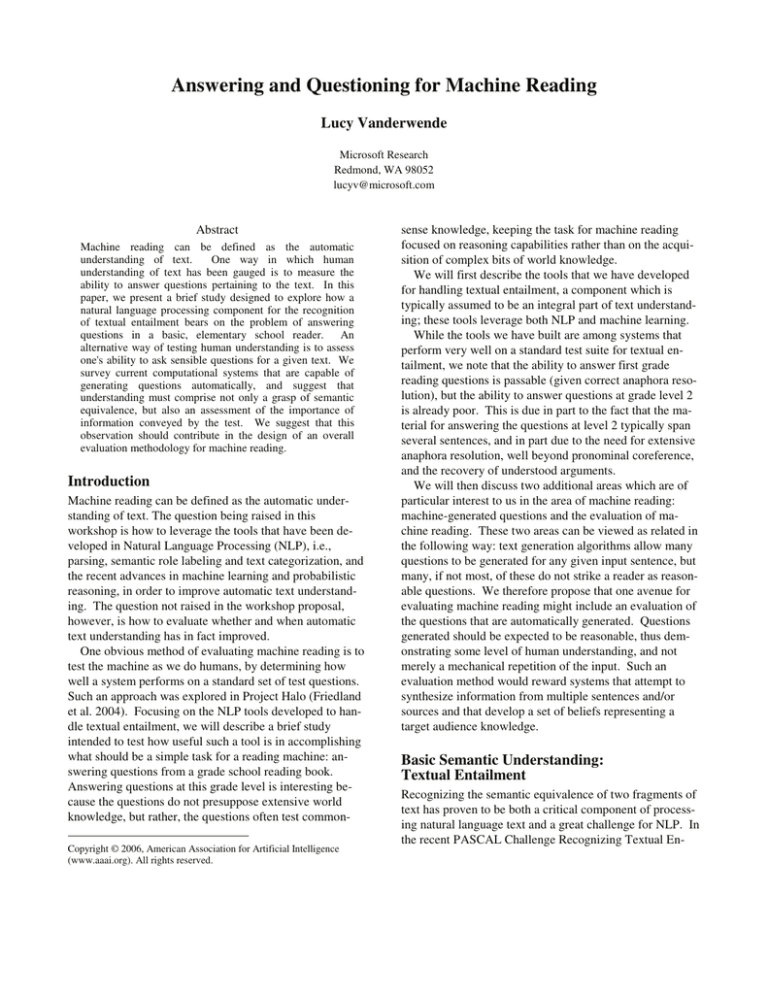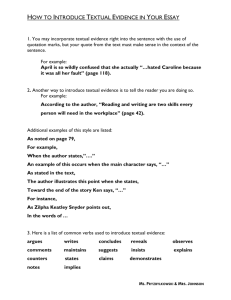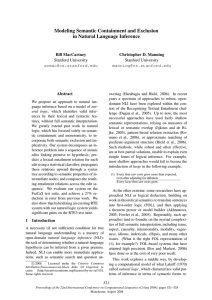
Answering and Questioning for Machine Reading
Lucy Vanderwende
Microsoft Research
Redmond, WA 98052
lucyv@microsoft.com
Abstract
Machine reading can be defined as the automatic
understanding of text.
One way in which human
understanding of text has been gauged is to measure the
ability to answer questions pertaining to the text. In this
paper, we present a brief study designed to explore how a
natural language processing component for the recognition
of textual entailment bears on the problem of answering
questions in a basic, elementary school reader. An
alternative way of testing human understanding is to assess
one's ability to ask sensible questions for a given text. We
survey current computational systems that are capable of
generating questions automatically, and suggest that
understanding must comprise not only a grasp of semantic
equivalence, but also an assessment of the importance of
information conveyed by the test. We suggest that this
observation should contribute in the design of an overall
evaluation methodology for machine reading.
Introduction
Machine reading can be defined as the automatic understanding of text. The question being raised in this
workshop is how to leverage the tools that have been developed in Natural Language Processing (NLP), i.e.,
parsing, semantic role labeling and text categorization, and
the recent advances in machine learning and probabilistic
reasoning, in order to improve automatic text understanding. The question not raised in the workshop proposal,
however, is how to evaluate whether and when automatic
text understanding has in fact improved.
One obvious method of evaluating machine reading is to
test the machine as we do humans, by determining how
well a system performs on a standard set of test questions.
Such an approach was explored in Project Halo (Friedland
et al. 2004). Focusing on the NLP tools developed to handle textual entailment, we will describe a brief study
intended to test how useful such a tool is in accomplishing
what should be a simple task for a reading machine: answering questions from a grade school reading book.
Answering questions at this grade level is interesting because the questions do not presuppose extensive world
knowledge, but rather, the questions often test commonCopyright © 2006, American Association for Artificial Intelligence
(www.aaai.org). All rights reserved.
sense knowledge, keeping the task for machine reading
focused on reasoning capabilities rather than on the acquisition of complex bits of world knowledge.
We will first describe the tools that we have developed
for handling textual entailment, a component which is
typically assumed to be an integral part of text understanding; these tools leverage both NLP and machine learning.
While the tools we have built are among systems that
perform very well on a standard test suite for textual entailment, we note that the ability to answer first grade
reading questions is passable (given correct anaphora resolution), but the ability to answer questions at grade level 2
is already poor. This is due in part to the fact that the material for answering the questions at level 2 typically span
several sentences, and in part due to the need for extensive
anaphora resolution, well beyond pronominal coreference,
and the recovery of understood arguments.
We will then discuss two additional areas which are of
particular interest to us in the area of machine reading:
machine-generated questions and the evaluation of machine reading. These two areas can be viewed as related in
the following way: text generation algorithms allow many
questions to be generated for any given input sentence, but
many, if not most, of these do not strike a reader as reasonable questions. We therefore propose that one avenue for
evaluating machine reading might include an evaluation of
the questions that are automatically generated. Questions
generated should be expected to be reasonable, thus demonstrating some level of human understanding, and not
merely a mechanical repetition of the input. Such an
evaluation method would reward systems that attempt to
synthesize information from multiple sentences and/or
sources and that develop a set of beliefs representing a
target audience knowledge.
Basic Semantic Understanding:
Textual Entailment
Recognizing the semantic equivalence of two fragments of
text has proven to be both a critical component of processing natural language text and a great challenge for NLP. In
the recent PASCAL Challenge Recognizing Textual En-
tailment (RTE)1, this task has been formulated as the problem of determining whether some text sentence T entails
some hypothesis sentence H (see Dagan et al. 2005). Some
examples of Text and Hypothesis sentences are:
T: Eyeing the huge market potential, currently led by
Google, Yahoo took over search company Overture
Services Inc last year.
H: Yahoo bought Overture.
True
T: Microsoft's rival Sun Microsystems Inc. bought
Start Office last month and plans to …
H: Microsoft bought Star Office.
False
T: Since its formation in 1948, Israel fought many
wars with neighboring Arab countries.
H: Israel was established in 1948.
True
T: The National Institute for Psychobiology in Israel
was established in May 1971 as …
H: Israel was established in 1971.
False
As these examples show, correctly identifying whether two
text segments are semantically equivalent or not is one
necessary facet of human or human-like understanding.
Another fundamental aspect of understanding, the ability to
distinguish important vs. background, will be explored in a
later section.
MENT: Microsoft Entailment
Given that the RTE task presents us with pre-selected pairs
of sentences, MENT takes the approach of predicting false
entailment rather than attempting to predict true entailment.
This approach is motivated by our earlier observations
(Vanderwende and Dolan 2005) that twice as many RTE
test items could be determined to be False, than True, using
syntax and thesaurus. MENT begins with logical form
representation of both text and hypothesis sentences, in
which all the relations between syntactic dependencies
have been labeled. Our algorithm proceeds as follows (described in detail in Snow et al. 2006):
1.
Parse each sentence, resulting in syntactic dependency graphs for the text and hypothesis
sentences.
2.
3.
4.
Attempt an alignment of each content node in the
dependency graph of the hypothesis sentence to
some node in the graph of the text sentence
Using the alignment, apply a set of syntactic heuristics for recognizing false entailment; if any
match, predict that the entailment is false.
If no syntactic heuristic matches, back off to a
lexical similarity model, with an attempt to align
detected paraphrases.
This system was among the top performing systems in
RTE-2 (see Bar-Haim et al. (2006), for details) and so is
representative of the state-of-the-art in systems attempting
to recognize textual entailment.
Reading Comprehension
In this section, we describe a brief study designed to explore the extent to which a textual entailment component is
useful in the task of answering the questions in a grade
school reader. A priori, we do not expect to need access to
extensive world knowledge, though the questions show
that commonsense knowledge and reasoning is very much
targeted in these exercises.
Consider a story and questions targeting reading comprehension at grade 1 level (Reading Comprehension,
grade 1, 1998, page 77):
See the boats! They float on water. Some boats have sails.
The wind moves the sails. It makes the boats go. Many people name their sailboats. They paint the name on the side of
the boat.
Questions:
1. What makes sailboats move?
2. Where do sailboats float?
As in RTE, we will manually choose the sentence pairs to
submit to the textual entailment system. The system predicts the correct answer for 2.
T: They float on water.
H: Where do sailboats float?
MENT computes the logical forms for each of these two
sentences (including basic anaphora resolution so that
"they" is coreferent with "boats") and computes the alignment of the nodes in the hypothesis sentence to the nodes
in the text sentence, as show below:
H: sailboat ← dsub ← float →locn →where
T: boat ← dsub ← float → locn →water
1
http://www.pascal-network.org/challenges/RTE.
No rules for detecting false entailment match, and so
MENT predicts True, indicating that this sentence contains
the correct answer. Note that in addition to textual entailment, simple pronominal coreference and lexical
synonymy were required in order to find the correct alignments.
For question 1, we chose the following pair of sentences
to submit to the MENT system:
T: It makes the boats go.
H: What makes sailboats move?
For this pair of sentences, the correct alignment can still be
established, and so the answer can be predicted correctly,
but more nodes require lexical synonym lookup, as shown
below:
H: what ←dsub← cause →dobj→ [move →dsub→ sailboat]
are not synonyms. Furthermore, there is no match for the
object in the Hypothesis, "eggs". This type of question,
which involves a chain of reasoning, is not appropriately
handled by textual entailment. Commonsense information
of the type that can be extracted from dictionaries (see
Vanderwende 1995) plays a role in detecting the answer2,
but basic reasoning capabilities are needed to further align
these sentences and discover the answer.
Note that it would be possible to search for the answer
on the WWW and discover the correct answer by mining
the information across a sizable set of sites, an approach
which would likely be taken by a typical QuestionAnswering system. However, given the expectation that a
second grader can correctly answer question 2 using only
this text, without recourse to external materials, we would
like to suggest that an information-mining approach to
machine reading does not actually address the core problem of machine reading, as the following example
illustrates.
Consider this example from a second grade reader3:
One night, not very far from here, a fox was looking for
food … But the sad thing was that there was no food to be
seen.
The fox was getting very hungry.
"If I don't find something to eat soon," said the fox to himself, "I shall die of hunger".
The fox looked in the bushes. He looked behind the trees.
He looked in the fields. He looked everywhere. Then he
came to a well.
T: wind ←dsub← cause →dobj→ [go →dsub→ boat ]
Now consider a different story, for grade 2, which is specifically targeting the young reader's ability to make
inferences (Reading Comprehension, grade 2, 1998):
A father sea horse helps the mother. He has a small sack, or
pouch, on the front of his body. The mother sea horse lays
the eggs. She does not keep them. She gives the eggs to the
father.
Questions:
1.
2.
What does the mother sea horse do with her eggs?
Where does the father sea horse put the eggs?
We choose the following optimal pairs of sentences for
questions 1 and 2. For question 1, MENT is able to predict
that this sentence is a good answer to the question.
Question 1
T: She gives the eggs to the father.
H: what does the mother sea horse do with her eggs?
Question: Where did the fox look for food?
As proficient readers, we can easily answer this question:
in the bushes, behind the trees, in the fields, and in the well.
We choose the following pair of sentences to submit to the
entailment system.
T: The fox looked in the bushes.
H: Where did the fox look for food?
MENT predicts False, since there is a concept in the hypothesis that is not aligned to any concept in the text,
namely "food". This can be overcome by a system is capable of recovering understood arguments.
Question 2:
T: He has a small sack, or pouch, on the front of his body.
H: Where does the father sea horse put the eggs?
For question 2, however, MENT rejects the pair as False
since there is no match for the verb associated with the
aligned subject of the hypothesis (see Snow et al. (2006)
for details concerning heuristics), "having" and "putting"
2
The information that "sack" and "pouch" are the typical
subject of activities such as "hold, keep, carry" can be
automatically identified from various dictionary definitions.
3
Excerpted from: The Fox and the Wold, Horsburgh, 2003.
The story continues:
The fox walked round the well and looked in. Suddenly, he
stopped. There, in the water, was the reflection of the moon.
"Ho, ho, ho!" he laughed. "What a luckily little fox I am!
Here I am thinking about buckets and ropes when in front of
my eyes is some food. Someone has thrown a whole cheese
into the well …"
The silly fox did not know that the cheese was not cheese. It
was the reflection of the moon.
The student must now answer these questions:
What did the fox think there was in the well?
What did the fox really see in the well?
Even if we manually select the pairs of sentences to submit
to the textual entailment, it is not clear what the optimal set
of pairs is. Below are some possibilities, though no pairing
will product the correct answer.
T: … in front of [fox's] eyes is some food.
H: What did the fox think there was in the well?
T: Someone has thrown a whole cheese into the well.
H: What did the fox think there was in the well?
T: It was the reflection of the moon.
H: What did the fox really see in the well?
What the appropriate steps in the reasoning process might
be exactly is a matter for investigation, but it is certainly
clear that in this case, we must rely solely on the interpretation of this text in order to answer the question correctly;
no amount of searching or pre-processing of the web will
produce the correct answer.
The importance of being important:
Question generation
Another method of testing reading comprehension and of
improving human learning is by means of question asking.
This method of testing confirms that students have identified the main ideas and indicate which part of the learning
material is important and worth testing (see, e.g., Chang et
al. 2005). In this section, we describe several computer
systems which have the capability of generating questions
automatically. A review of these systems makes clear that
the process of asking good questions, and identifying
which part of the text is worth generating questions about,
is still a real challenge.
Ureel et al., 2005, build on the tradition of the Socratic
method of learning by creating a computer system, Ruminator, that reflects on the information it has acquired and
poses questions in order to derive new information. Their
hypothesis is that "a system that can generate its own ques-
tions to work on will be able to learn the ways in which
new information fits with existing knowledge, detect missing knowledge, and provide better explanations than
systems without this ability" (Ureel et al. 2005). Ruminator takes as input simplified sentences in order to focus on
question generation rather than handling syntactic complexity, and is capable of asking typical Journalists'
questions, who, what, when, where, why and how. It is
unclear whether Ruminator can ask questions that span
more than one sentence, but it is reported that even a single
sentence generated 2052 questions. The authors note that it
is important "to weed out the easy questions as quickly as
possible, and use this process to learn more refined question-posing strategies to avoid producing silly or obvious
questions in the first place" (Ureel et al. 2005). Furthermore, some of the examples of automatically generated
questions provided are semantically ill-formed and answering these would presumably not lead to any enhanced
knowledge: "Is it true that the City of San Antonio's spouse
is Chile?" (Ureel et al. 2005). A key component that appears to be missing from the system design is an estimation
of the utility, or informativeness, of an automatically generated question.
Mitkov and An Ha (2003) describe a computer system
for generating multiple-choice questions automatically,
"based on the premise that questions should focus on key
concepts rather than addressing less central and even irrelevant concepts or ideas" (Mitkov and An Ha 2003). In
order to accomplish this, the system comprises a set of
transformational rules, a shallow parser, automatic term
extraction and word sense disambiguation. Questions are
only asked in reference to domain-specific terms, to ensure
that the questions are relevant, and sentences must have
either a subject-verb-object structure or a simple subjectverb structure, which limits questions to core concepts in
the sentence; naturally, questions are only generated one
sentence at a time. They tested this method on a linguistics
textbook and found that 57% were judged worthy of keeping as test items, of which 94% required some level of
post-editing. 43% of the automatically generated questions
were rejected as either not focusing on a central concept, or
requiring too much post-editing. One example of a generated question is (Mitkov and An Ha 2003):
"which kind of language unit seem to be the most obvious
component of language, and any theory that fails to account
for the contribution of words to the functioning of language
is unworthy of our attention"
This question was considered worthy, after revising the
question by eliminating the second coordinate constituent.
Schwartz et al. (2004) describe a system for generating
questions which also comprises the NLP components of
lexical processing, syntactic processing, logical form, and
generation. The input to the generation component is a
logical form, and from this logical form the typical Journalist questions can be generated. This system uses
summarization as a pre-processing step as a proxy for identifying information that is worth asking a question about.
Questions can be generated for any constituent, including
prepositional phrases. For the input sentence "At school,
John eats rice every day", a number of questions can be
generated, among which "Where does John eat rice every
day?" Nevertheless, the authors note that "limiting/selecting questions created by Content QA Generator is
difficult" (Schwartz et al. 2004).
Finally, Harabagiu et al. (2005) describes an approach to
automatic question generation using syntactic patterns,
together with semantic dependencies and named entity
recognition. Their purpose was "to generate factoid questions automatically from large text corpora" (Harabagiu et
al. 2005). User questions were then matched against these
pre-processed factoid questions in order to identify relevant answer passages in a Question-Answering system.
While no examples of automatically generated questions
are provided, this study does report a comparison of the
retrieval performance using only automatically generated
questions and manually-generated questions: 15.7% of the
system responses were relevant given automatically generated questions, while 84% of the system responses were
deemed relevant with manually-generated questions. The
discrepancy in performance indicates that significant difficulties remain.
Questioning as Evaluation
The studies discussed above show that identifying which
text segments are important and worth asking questions
about remains a great challenge for computational systems.
From the few examples presented in these studies, it appears easy for humans to judge whether an automatically
generated question is sensible and not merely mechanical,
obvious and/or nonsensical.
Given that machine reading, like human reading, should
include an understanding of what information is important
and in focus for a particular text, and given that adequate
question generation is taken as a demonstration of understanding and will lead to enhanced learning, then we might
consider how to incorporate question generation in an
evaluation methodology for machine reading.
Evaluating questions will necessarily involve human
judgment, given the many questions that can sensibly be
asked for a given text, though human judgment is very
quick and should achieve high agreement on this task. A
human-in-the-loop has the additional disadvantage that the
evaluation metric cannot be used during system development, which is generally considered necessary for training
machine-learned algorithms. These disadvantages should
be weighed against nourishing research directed at establishing the importance of information conveyed by text
rather than treating the text as a great morass of facts all of
which are equally important.
Conclusion
We hope to have shown that while textual entailment is a
basic component for understanding the semantic content of
a given text, it alone is not sufficient for the task of answering questions in an elementary grade reader. In order
to accomplish this, systems must expand their capabilities
to advanced anaphora resolution, recovering understood
arguments, and components that begin to identify the necessary reasoning steps. The advantage of focusing on
answering questions in basic readers is that very little external world knowledge is assumed, and the focus is rather
on commonsense knowledge.
We discussed that a complementary and/or alternative
way to test human-level understanding of a given text is to
evaluate how sensible automatically-generated questions
are. Current systems have demonstrated the ability to generate questions, but all systems suffer in over-generating
questions, i.e., generating questions that a human would
easily reject as being nonsensical. For this reason, we suggest that at least one component of an evaluation
methodology for machine reading should be an evaluation
of the quality of questions. This will lead us to research
leveled at determining the important information that humans derive from a given text, and not only a rote
memorization of the facts that the text represents. Question generation tests the identification of important
information, one aspect of human reading and understanding, in a way that question answering does not.
References
Bar-Haim, R.; Dagan, I.; Dolan, W.B.; Ferro, L.; Giampiccolo, D.; Magnini, B.; and Szpektor, I. 2006. The Second
PASCAL Recognising Textual Entailment Challenge. In
Proceedings of the Second PASCAL Challenges Workshop on Recognising Textual Entailment.
Dagan, I.; Glickman, O.; and Magnini, B. 2006. The
PASCAL Recognising Textual Entailment Challenge. Lecture Notes in Computer Science, Volume 3944, Jan 2006,
Pages 177-190.
Friedland, N.; Allen, P.G.; Witbrock, M.; Matthews, G.;
Salay, N.; Miraglia, P.; Angele, J.; Staab, S.; Israel, D.;
Chaudhri, V.; Porter, B.; Barker, K.; and Clark, P. 2004.
Towards a Quantitative, Platform-Independent Analysis of
Knowledge Systems, In The Ninth International Confer-
ence on the Principles of Knowledge Representation and
Reasoning (KR2004)
Harabagiu, S.; Hickl, A.; Lehmann, J.; and Moldovan, D.
2005. Experiments with Interactive Question-Answering.
In Proceedings of the 43rd Annual Meeting of the Association for Computational Linguistics (ACL05).
Horsburgh, N. 2003. Oxford Reading Circle, book 2. Oxford University Press, New Delhi, India.
Mitkov, R., and An Ha, L. 2003. Computer-Aided Generation of Multiple-Choice Tests. In Proceedings of the HLTNAACL 2003 Workshop on Building Educational Applications Using Natural Language Processing, Edmonton,
Canada, May, pp. 17 – 22
Reading Comprehension, grade 1. 1998. School Specialty
Publishing.
Reading Comprehension, grade 2. 1998. School Specialty
Publishing.
Schwartz, L.; Aikawa, T.; and Pahud, M. 2004. Dynamic
Language Learning Tools. In Proceedings of the 2004 InSTIL/ICALL Symposium, June 2004.
Snow, R.; Vanderwende, L.; and Menezes, A. 2006. Effectively using syntax for recognizing false entailment. In
Proceedings of HLT/NAACL 2006.
Ureel II, L. C.; Forbus, K.; Riesbeck, C.; and Birnbaum, L.
2005. Question Generation for Learning by Reading. In the
Proceedings of the AAAI Workshop on Textual Question
Answering, Pittsburgh, Pennsylvania. July 2005
Vanderwende, L., and Dolan, W.B. 2006. What syntax can
contribute in entailment task. In Lecture Notes in Computer Science, Volume 3944, Jan 2006, pp. 205-216.
Vanderwende, L. 1995. The Analysis of Noun Sequences
using Semantic Information Extracted from On-Line Dictionaries. Ph.D. thesis, Dept. of Linguistics, Georgetown
University, Washington, D.C.


![2 Meaning[1]](http://s3.studylib.net/store/data/009749903_1-6a50d932662097cf54d6087a0fbfce74-300x300.png)




